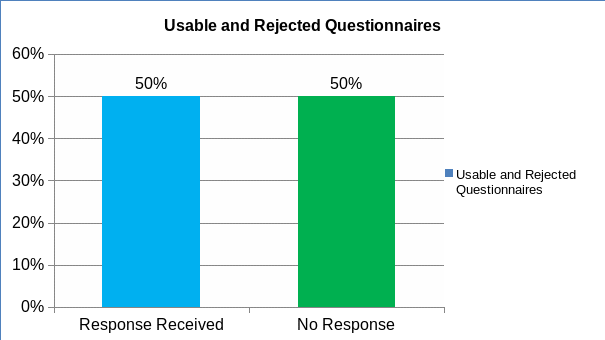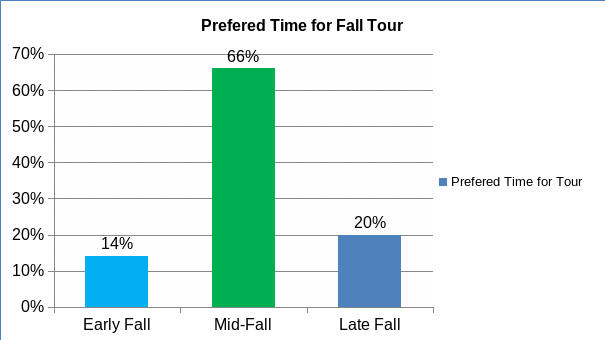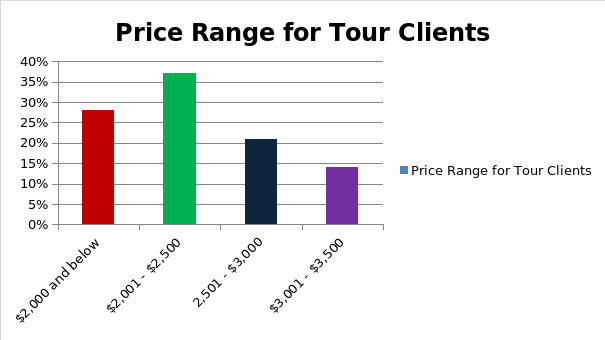Introduction
With authorization as the tour coordinator for Covington International Travel, I have the legal right to plan vacation travel tours for the company and promote them.
It is a requirement that all reports are being submitted to the vice president for review and approval by the executive committee. Therefore, it is mandatory to submit this tour report I compiled for your review and further considerations.
In order to secure tour clients for the upcoming fall tour season in the Far East, it is important that the process of developing the tour plan is sped up for early completion.
The purpose of this study is to establish the interest in tours and the broad guidelines for specific travel to the Far East, in order to facilitate the development of a tour plan for the upcoming fall tour season.
The scope of the study shall be limited to gathering information about interest by former tour clients in spending a vacation in the Far East. Also, the vacation destinations will be limited to five pre-selected cities namely; Bangkok, Hong Kong, Manila, Osaka, Seoul, Singapore, and Tokyo.
Methods
The targeted participants of the questionnaire survey comprised mainly of former tour clients of Covington International Travel. The former clients were selected because they are the most likely to accept the offer since they have experienced our well-planned services some times before. The study was aimed at getting information on their interests in spending a vacation in the Far East during the upcoming fall tour season. The study was narrowed down to seven major Cities which are: Bangkok, Hong Kong, Manila, Osaka, Seoul, Singapore, and Tokyo. A random sampling technique was used in identifying the Cities to be the tourist destinations for the upcoming fall tour season.
Random Sampling Technique
- The destination area for the upcoming tour season was established as the Far East.
- 21 potential cities were randomly selected from a map of the Far East.
- Names of each selected city were written on small pieces of paper, put in one container, and mixed thoroughly.
- Seven cities were to be selected from the container by equal chances.
- The first paper was picked, outcome recorded, then returned into the container and thoroughly mixed again.
- The second paper was picked, outcome recorded, then returned into the container and thoroughly mixed again.
- This procedure was repeated up to the last (seven) paper picked and recorded.
Sampling Results and Procedures
From the sampling, seven cities were obtained which included; Bangkok, Hong Kong, Manila, Osaka, Seoul, Singapore, and Tokyo.
After the sampling procedure was completed and all destination cities were identified, further secondary research was conducted to identify the best rates offered in each location in terms of flight costs, hotel rates, meals, and other necessities. Thereafter, the formal questionnaire survey to be sent to our former clients (target) was prepared. A number of alternatives were provided where the respondents were at will to select either one or more alternatives depending on their preferences.
Through the aid of a computer-generated random sampling procedure, a total of 600 former tour clients were selected for the questionnaire. Therefore, a total of 600 questionnaires were sent to each of the 600 selected respondents via mail: Each of the questionnaires was accompanied by a cover letter explaining the purpose of the survey and a pre-addressed, stamped envelop. A response rate of 50% was achieved with 300 respondents sending back their responses.
A quantitative analysis was then conducted in analyzing the responses. The process involved the use of statistical and other mathematical techniques in quantifying the number of respondents with reference to particular destinations. Thereafter, the analysis was used in making general conclusions and recommendations. The following shows a sample table describing the research design approaches that were employed in the study (“Research Approach and Methods” 3):
Table 1.0: Research Design Approach
Findings
Out of 600 questionnaires sent to respondents, only 300 were sent back. Therefore, a response rate of 50% was realized. The received questionnaires are assumed as the usable data while the “no response” questionnaires are assumed as the rejected responses. Figure 1.0 below shows the response rates in a tabulated form.

Different responses were received with regards to the appropriate time during the fall tour season the respondents may be available for vacation. According to the responses received, 14% (40), 66% (196), and 20% (64) of the respondents claimed to be available for vacation during early fall, mid-fall, and late fall respectively. Figure 2.0 below, simplifies the results as appropriate.

Figure 3.0 below indicates the preference cities as selected by the respondents. The figures may slightly deviate from our response size because respondents were allowed to select more than one city as they wished. As such, the responses yielded the following results: Bangkok (18%), Hong Kong (17%), Manila (14%), Osaka (9%), Seoul (10%), Singapore (15%), and Tokyo (17%). As shown in figure 3.0, the most preferred city is Bangkok (18%), followed closely by Hong Kong and Tokyo (17%), while the least preferred city is Osaka and Seoul at 9% and 10% respectively.

Figure 4.0 below shows the willingness of responding to spend at certain limits during the forthcoming vacation. As shown in the figure most of the respondents lie within the $2,001 – $2,500.

Conclusions
In conclusion, the tour plan is expected to be successful since most of the essential data has been collected, analyzed and appropriate measures taken. In addition, the following is the expected schedule to be used for the departure time, cities to visit, and the price range.
Table 2.0: Proposed Schedule for Departure and.
Recommendations
Putting in mind that the global positioning of the Far East, planning should be done strategically in order to have appropriate landings. Therefore, it is my recommendation that all flights are followed as scheduled. As it may deem necessary, all flights should be scheduled for no later than 10.00 a.m. In order of preference, Bangkok should be given the first priority followed by Hong Kong and Tokyo because most of the tour clients are more willing to visit the cities.
Table 3.0: Proposed Schedule for Departure Price Range.
Works Cited
“Research Approach and Methods.” Oulu University Library. Herkules.oulu.fi, 2002. Web.